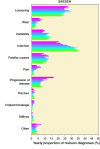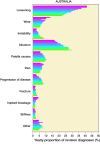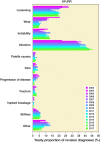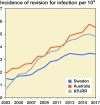Variation and trends in reasons for knee replacement revision: a multi-registry study of revision burden
- PMID: 33263453
- PMCID: PMC8159200
- DOI: 10.1080/17453674.2020.1853340
Variation and trends in reasons for knee replacement revision: a multi-registry study of revision burden
Abstract
Background and purpose - Studies describing time-related change in reasons for knee replacement revision have been limited to single regions or institutions, commonly analyze only 1st revisions, and may not reflect true caseloads or findings from other areas. We used revision procedure data from 3 arthroplasty registries to determine trends and differences in knee replacement revision diagnoses.Patients and methods - We obtained aggregated data for 78,151 revision knee replacement procedures recorded by the Swedish Knee Arthroplasty Register (SKAR), the Australian Orthopaedic Association National Joint Replacement Registry (AOANJRR), and the Kaiser Permanente Joint Replacement Registry (KPJRR) for the period 2003-2017. Equivalent diagnosis groups were created. We calculated the annual proportions of the most common reasons for revision.Results - Infection, loosening, and instability were among the 5 most common reasons for revision but magnitude and ranking varied between registries. Over time there were increases in proportions of revisions for infection and decreases in revisions for wear. There were inconsistent proportions and trends for the other reasons for revision. The incidence of revision for infection showed a uniform increase.Interpretation - Despite some differences in terminology, comparison of registry-recorded revision diagnoses is possible, but defining a single reason for revision is not always clear-cut. There were common increases in revision for infection and decreases in revision for wear, but variable changes in other categories. This may reflect regional practice differences and therefore generalizability of studies regarding reasons for revision is unwise.
Figures





Similar articles
-
Increases in the rates of primary and revision knee replacement are reducing: a 15-year registry study across 3 continents.Acta Orthop. 2020 Aug;91(4):414-419. doi: 10.1080/17453674.2020.1749380. Epub 2020 Apr 14. Acta Orthop. 2020. PMID: 32285749 Free PMC article.
-
Have the frequency of and reasons for revision total knee arthroplasty changed since 2000? Comparison of two cohorts from the same hospital: 255 cases (2013-2016) and 68 cases (1991-1998).Orthop Traumatol Surg Res. 2019 Jun;105(4):639-645. doi: 10.1016/j.otsr.2019.01.025. Epub 2019 May 11. Orthop Traumatol Surg Res. 2019. PMID: 31088772
-
Trends in revision hip and knee arthroplasty observations after implementation of a regional joint replacement registry.Can J Surg. 2016 Sep;59(5):304-10. doi: 10.1503/cjs.002916. Can J Surg. 2016. PMID: 27438053 Free PMC article.
-
Kaplan-Meier Survival Analysis Overestimates the Risk of Revision Arthroplasty: A Meta-analysis.Clin Orthop Relat Res. 2015 Nov;473(11):3431-42. doi: 10.1007/s11999-015-4235-8. Clin Orthop Relat Res. 2015. PMID: 25804881 Free PMC article. Review.
-
Use of National Joint Registries to Evaluate a New Knee Arthroplasty Design.J Arthroplasty. 2020 Feb;35(2):413-416. doi: 10.1016/j.arth.2019.09.018. Epub 2019 Sep 16. J Arthroplasty. 2020. PMID: 31629622 Review.
Cited by
-
Tibiofemoral dynamic stressed gap laxities correlate with compartment load measurements in robotic arm-assisted total knee arthroplasty.Bone Jt Open. 2021 Nov;2(11):974-980. doi: 10.1302/2633-1462.211.BJO-2021-0066.R1. Bone Jt Open. 2021. PMID: 34818899 Free PMC article.
-
Prevalence, risk factors, microbiological results and clinical outcome in unexpected positive intraoperative cultures in unclear and presumed aseptic hip and knee revision arthroplasties - A ten-year retrospective analysis with a minimum follow up of 2 years.J Orthop Translat. 2024 Aug 17;48:156-162. doi: 10.1016/j.jot.2024.08.002. eCollection 2024 Sep. J Orthop Translat. 2024. PMID: 39247790 Free PMC article.
-
Comparison of medium- and long-term total knee arthroplasty follow-up with or without tourniquet.BMC Musculoskelet Disord. 2025 Feb 27;26(1):205. doi: 10.1186/s12891-025-08462-w. BMC Musculoskelet Disord. 2025. PMID: 40016694 Free PMC article.
-
Is Wear Still a Concern in Total Knee Arthroplasty With Contemporary Conventional and Highly Crosslinked Polyethylene Tibial Inserts in the mid- to Long-Term?Arthroplast Today. 2024 Oct 30;30:101550. doi: 10.1016/j.artd.2024.101550. eCollection 2024 Dec. Arthroplast Today. 2024. PMID: 39534215 Free PMC article.
-
Septic complications are on the rise and aseptic loosening has decreased in total joint arthroplasty: an updated complication based analysis using worldwide arthroplasty registers.Arch Orthop Trauma Surg. 2024 Dec;144(12):5199-5204. doi: 10.1007/s00402-024-05379-2. Epub 2024 May 25. Arch Orthop Trauma Surg. 2024. PMID: 38795186 Free PMC article.
References
-
- AOANJRR . Annual report: hip, knee & shoulder arthroplasty. AOANJRR; 2019. Available from https://aoanjrr.sahmri.com/annual-reports-2019.
-
- Faris P M, Ritter M A, Pierce A L, Davis K E, Faris G W.. Polyethylene sterilization and production affects wear in total hip arthroplasties. Clin Orthop Relat Res 2006; 453: 305–8. - PubMed
MeSH terms
LinkOut - more resources
Full Text Sources
Other Literature Sources
Medical
